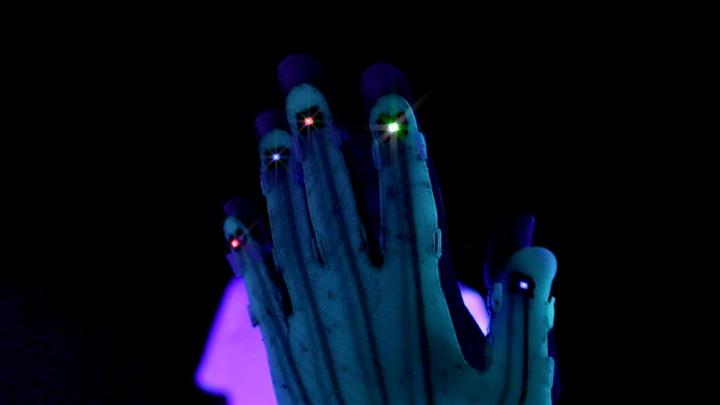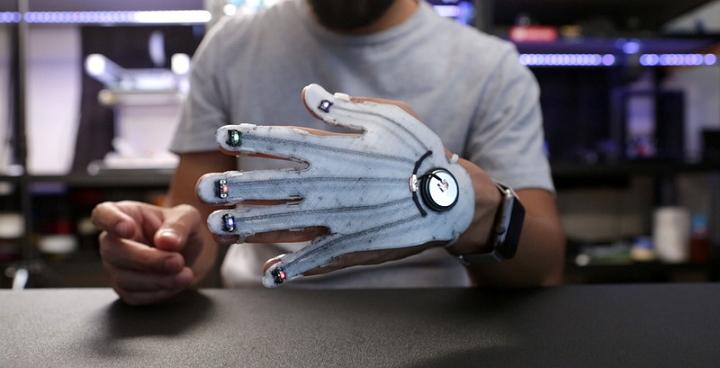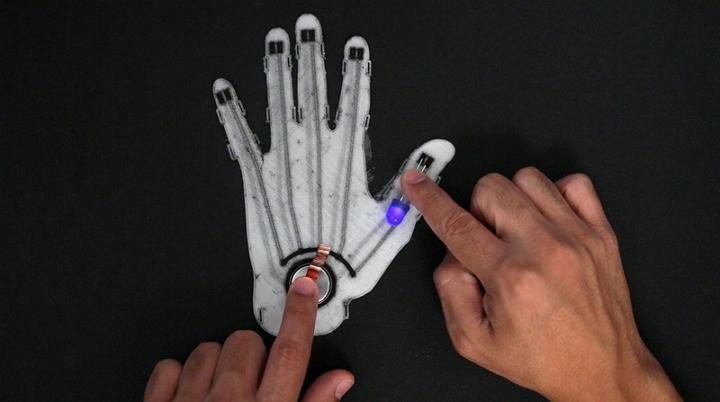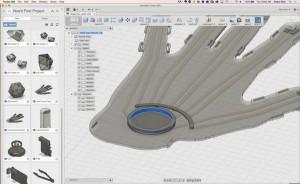 There are some things you just don’t know you need until you see them realized as actual objects, and this may well be one of those things – a 3D printed glove made from flexible NinjaFlex and conductive filament which uses an integrated, semi-flexible circuit and a coin cell battery to power 5 LED sequins.
There are some things you just don’t know you need until you see them realized as actual objects, and this may well be one of those things – a 3D printed glove made from flexible NinjaFlex and conductive filament which uses an integrated, semi-flexible circuit and a coin cell battery to power 5 LED sequins.
The Ruiz Brothers of Adafruit fame are a creative team from West Palm Beach, Florida who take influences like cartoons, visual effects, and videos games to build cool things with 3D printing and electronics. Back in 2013, the brothers shifted their focus to 3D printing, and they now design products and offer 3D printing services from their home studio.
 For the Party Glove, they began by tracing one of their hands on paper, and rather than scan the drawing, they opted to take a photo of it with a smartphone. The photo was imported into their drawing app of choice, and they used vector paths to create the outline which they then imported into CAD software.
For the Party Glove, they began by tracing one of their hands on paper, and rather than scan the drawing, they opted to take a photo of it with a smartphone. The photo was imported into their drawing app of choice, and they used vector paths to create the outline which they then imported into CAD software.
The brothers say there are a few tricks which will come in handy and smooth the way to making your glove. One of those, scaling paths in Illustrator or Photoshop, requires that you not use millimeters as the units of measurements as that may cause unexpected scaling issues.
They also warn that you should test to make certain your hand isn’t too large to actually fit on your 3D printer’s bed before proceeding.
 Next up, they measured the distance between the two soldering pads on the Sequin LEDs to help them create the conductive pads they’d need later for the lighting effect. They traced using single vector lines via the pen tool in Photoshop or Illustrator and drew out the ground and power traces for each finger in a stroke thickness of at least 5px thick. They say the width of the trace is to ensure that the finished product will have the necessary conductivity along the trace.
Next up, they measured the distance between the two soldering pads on the Sequin LEDs to help them create the conductive pads they’d need later for the lighting effect. They traced using single vector lines via the pen tool in Photoshop or Illustrator and drew out the ground and power traces for each finger in a stroke thickness of at least 5px thick. They say the width of the trace is to ensure that the finished product will have the necessary conductivity along the trace.
The project is powered with a coin cell battery, and they suggest running a print test of just the battery holder to ensure it has good tolerances and fits the battery you intend to use.
Attaching the NinjaFlex hand to the actual hand required the use of add tabs to each finger to be used as straps, and each finger has small slots through which straps or rubber bands as threaded to complete the mounts. The brothers say the straps can also be 3D printed in NinjaFlex.
They provided, of course, a detailed guide to show users how to use the conductive filament and glow-in-the-dark NinjaFlex to create this flexible, LED wearable.
 According to the Brothers, the concepts in this latest of their projects could be used to create elements for cosplay props and costumes. By integrating conductive filament into the design, the circuitry was successfully embedded; the conductive filament can also be used to fabricate capacitive touch sensors.
According to the Brothers, the concepts in this latest of their projects could be used to create elements for cosplay props and costumes. By integrating conductive filament into the design, the circuitry was successfully embedded; the conductive filament can also be used to fabricate capacitive touch sensors.
To make the project, you will need NinjaFlex Glow in the Dark Filament, Diffused LEDs in 5mm and 3mm sizes or Adafruit LED Sequins, Conductive Filament from ProtoPasta, Bare Conductive Paint and a CR2032 Lithium Coin Cell battery.
You can download all the files you’ll need to get started at Adafruit, and they suggest that you print them with 20% infill at 45mm/s print speed and 120mm/s travel speed. All in all, the project took about 1.5 hours to print.
Subscribe to Our Email Newsletter
Stay up-to-date on all the latest news from the 3D printing industry and receive information and offers from third party vendors.
You May Also Like
Gorilla Sports GE’s First 3D Printed Titanium Cast
How do you help a gorilla with a broken arm? Sounds like the start of a bad joke a zookeeper might tell, but it’s an actual dilemma recently faced by...
Nylon 3D Printed Parts Made More Functional with Coatings & Colors
Parts 3D printed from polyamide (PA, Nylon) 12 using powder bed fusion (PBF) are a mainstay in the additive manufacturing (AM) industry. While post-finishing processes have improved the porosity of...
$25M to Back Sintavia’s Largest Expansion of Metal 3D Printing Capacity Since 2019
Sintavia, the digital manufacturing company specializing in mission-critical parts for strategic sectors, announced a $25 million investment to increase its production capacity, the largest expansion to its operations since 2019....
Velo3D Initiates Public Offering in a Bid to Strengthen Financial Foundations and Drive Future Growth
Velo3D (NYSE: VLD) has been among a number of publicly traded 3D printing firms that have attempted to weather the current macroeconomic climate. After posting a challenging financial report for 2023,...
































